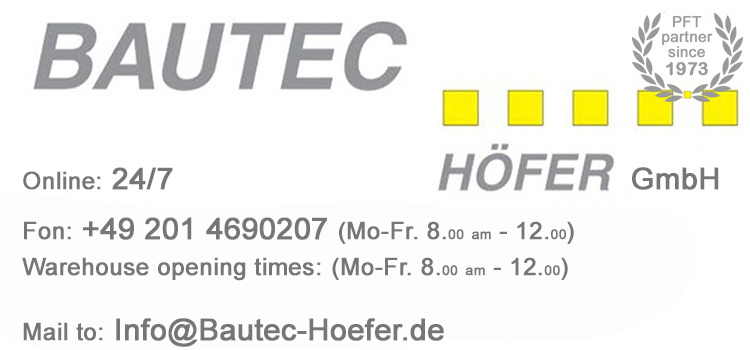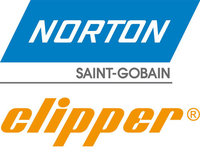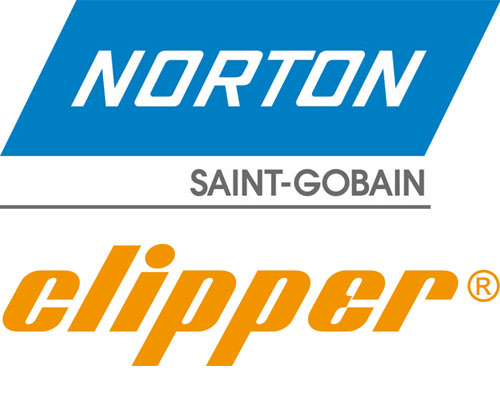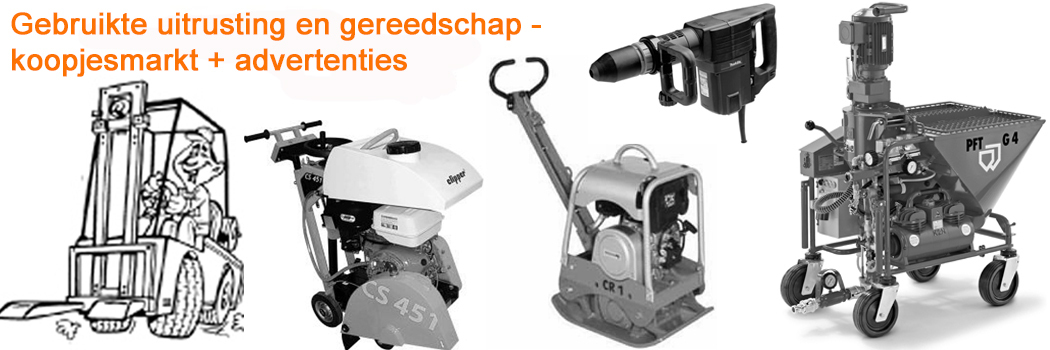Verkoop van bouwgereedschappen en werktuig = kwaliteit en services voor uw succes:
»een optimale prijs-prestatieverhouding »betrouwbaarheid en flexibiliteit »technische know-how en vakkundige advies »centrale ligging in het hart van het Ruhrgebied

-
De originele PFT-OnlineShop
- PFT scala van machines
- Mengen-transporteren-doseren
- Rotor/Stator
- Spuitpistolen en accessoires
- Materiaalslangen
- PFT gereedschappen
- Injectie kap & Co
- PFT water & lucht
-
PFT reserveonderdelen
- Water-/ lucht-armatuur
- O-delen Compressor
- Mengpijp & Trechter
- Schakelkast
- Stekkers en accessoires
- Kogelkranen
- kleine onderdelen
- Spuitpistolen
- Slangen onderdelen
- Onderdelen MIXER
- Onderdelen CUTMASTER & Co
- Dekvloer egalisieren pin
- Onderdelen RITMO
- SILOMAT onderdelen
- Onderdelen horizontale mengers
- Onderdelen worm pompen
- Onderdelen MULTIMIX
- Onderdelen SAMBA
- ... Meer
- Aanbod van de maand + nieuwe producten
-
PFT-onderdelen voor machines A-Z
- Onderdelen BOLERO
- Onderdelen HM 106
- Onderdelen HM 2002
- Onderdelen HM 2006
- Onderdelen HM 24
- Onderdelen HM 5
- Onderdelen LOTUS XS
- Onderdelen LOTUS XL
- Onderdelen MULTIMIX 140 plus
- Onderdelen RITMO M / RITMO L
- Onderdelen RITMO L plus
- Onderdelen RITMO XL
- Onderdelen SILOMAT trailer
- Onderdelen SILOMAT transplus
- Onderdelen SWING M
- Onderdelen SWING L
- Onderdelen SWING L airless
- Onderdelen ZP3 M
- Onderdelen ZP3 L
- Onderdelen ZP3 XL
- Onderdelen ZP3 XXL
- ... Meer
- Numerieke lijst PFT artikelen
- PFT producten niet meer leverbaar
-
PFT-onderdelen gesorteerd per machines
- Onderdelen BOLERO
- Onderdelen CUTMASTER
- Onderdelen G4 (tot 2012)
- Onderdelen G4 X
- Onderdelen G5
- Onderdelen HM 106
- Onderdelen HM 2002
- Onderdelen HM 2006
- Onderdelen HM 24
- Onderdelen HM 5
- Onderdelen LOTUS XS
- Onderdelen LOTUS XL
- Onderdelen MONOJET
- Onderdelen MULTIMIX 140 plus
- Onderdelen RITMO M / RITMO L
- Onderdelen RITMO L plus
- Onderdelen RITMO XL
- Onderdelen SILOMAT trailer
- Onderdelen SILOMAT transplus
- Onderdelen SWING M
- Onderdelen SWING L
- Onderdelen SWING L airless
- Onderdelen ZP3 M
- Onderdelen ZP3 L
- Onderdelen ZP3 XL
- Onderdelen ZP3 XXL
- COLLOMIX®
- Winkel "Elektro & meer"
-
NORTON-Clipper-Shop
- Diamant voor handhelds
- Tegelzagen
- Diamond steenzagen
- Vloerzagen
- Kernboormachines en boorkronen
- Muurzagen
- Concrete troffels
- Slijp- en polijstmachines
- Onderdelen en delenlijsten
-
Onderdelen voor steenzagen
- CFW onderdelen
- CLIPPER CGW onderdelen
- CLIPPER CM351 onderdelen
- CM41 onderdelen
- CM42 onderdelen
- Onderdelen JCW Junior
- CM401 onderdelen
- CM501 onderdelen
- ISC onderdelen
- ISM onderdelen
- JUMBO 651 onderdelen
- CM70 onderdelen
- CLIPPER JUMBO 900 + 1000
- CHW & CHW-T onderdelen
- CMR351 onderdelen
- CST 100-120-150 onderdelen
- CST 120 UNO onderdelen
- CST 100-120 ALU onderdelen
- ... Meer
- Onderdelen vloerzagen
- Kleurcodering systeem
- Slijpschijven
- Veiligheidsinstructies
- Numerieke lijst artikelen
- Shop voor KIP-tape
-
FLEX®-OnlineShop
- Haakse slijpmachines
- Accessoires haakse slijpers
- Accu machines
- Toebehoor accu machines
- Wand- en plafondschuurder
- Toebehoor FLEX Giraffe®
- Polijstmachines
- Accessoires FLEX polijstmachines
- Veiligheidsstofzuiger
- Toebehoor FLEX stofzuiger
- Metaaloppervlakte-bewerking
- Toebehoor metaaloppervlakte-bewerking
- Saneringsslijpers
- Accessoires renovatie slijpers
- Oppervlaktebewerking schuren
- Accessoires schuurmachines
- Mengers
- Accessoires voor mixer
- Boorhamers
- Accessoires FLEX boorhamers
- Steenbewerking
- Accessoires voor steenbewerking
- Zagen FLEX®
- Accessoires FLEX zagen
- Laser-meettechniek
- Accessoires voor lasers
- FLEX in de L-BOXX®
-
Toebehoor en onderdelen
- Haakse slijpers - Onderdelen en toebehoor
- FLEX accu machines toebehoor en onderdelen
- FLEX-Giraffe - Onderdelen en toebehoor
- FLEX polijstmachines - toebehoor en onderdelen
- FLEX stofzuiger - Toebehoor en onderdelen
- Saneringsslijpers - Toebehoor en onderdelen
- FLEX mengers - Onderdelen en toebehoor
- Boorhamers - Onderdelen en toebehoor
- Steenbewerking - toebehoor en onderdelen
- FLEX zagen toebehoor & onderdelen
- Metaaloppervlakte-bewerking - Toebehoor en onderdelen
- Onderdelen lijsten download
- ... Meer
- Alfabetische productassortiment
- Oude modellen (niet meer verkrijgbaar)
- 1-2-3 Landmeetkunde
- EGO OnlineShop
- Shop voor TuLa-Bouw
-
Bouw tools algemen
- Schoppen, spaden en harken
- Hamers, bijlen, beitels
- Bezems en borstels
- Houten handvats
- Water / lucht slangen
- Emmers, potten, blikjes
- Metselaars en stukadoorstroffels
- Tangen, scharen, betonscharen
- Laser- & meten-technologie
- Handzagen en zaagbladen
- touwen en hefwerktuigen
- Boren en beitels
- Schilderenwerktuig
- Nagels, deuvels, draad
- Werkplaats producten
- Artikelen voor vloer en beton bouwers
- Krause ladders
- Speciale aanbiedingen
- Veiligheid Shop
- Jung-Henkelmann online winkel
-
Gips & stuckwerk winkel
- Jung-Henkelmann online winkel
- Alu wandrij
- Pleisterspanen
- Schuurborden
- Spackmessen en spatels
- Metselaars en stukadoorstroffels
- Speciale stucwerktuigen
- Andere nuttige werktuigen
- Schilders tools & borstels
- Mengers en roerwerken
- Werkkledding voor stukkadoors
- PM - Uelzener - M-tec
- ECO slangen en accessoires
- Rotor/stator D-pompen
- ECO wormen en wormmantels
- Spuitpistolen ECO
- Gebruikte machines
- Numerieke artikelenlijst BAUTEC
- Over ons
| ma |
08:00 |
- |
12:00 |
| di |
08:00 |
- |
12:00 |
| wo |
08:00 |
- |
12:00 |
| do |
08:00 |
- |
12:00 |
| vr |
08:00 |
- |
12:00 |
| za | Gesloten |
| zo | Gesloten |

Sitemap (Shops in de Shop) NORTON-Clipper-Shop Veiligheidsinstructies
Veiligheidsinstructies

VEILIG GEBRUIK VAN DROOG OF NAT SNIJDENDE DIAMANTZAGEN
De veiligheid is de belangrijkste factor bij het NORTON ontwerpt en fabriceert diamantzagen.
Daarom bieden alle droog of nat zagen diamantzagen een hoge mate van veiligheid tijdens het gebruik, zolang ze goed gebruikt!
Om te voorkomen dat misbruik en om de veiligste en meest economische prestaties te garanderen van uw NORTON diamantschijf, is het essentieel dat de volgende aanbevelingen in acht worden genomen vóór de start en tijdens het gebruik:

BEFORE OPERATION
- YOUR BLADE
- Check the blade is the correct size and type for your machine and application.
- Diameters of both bore and machine shaft must be equal.
- Check for damage, i.e. cracks in the gullets, out of round bore hole, missing or broken segments, lost of steel centre tension. If in doubt, do not use and report.
- Check the health & safety information is clearly marked on the blade, i.e. diameter, bore size and maximum speed, which should never be exceeded (see Conformity).
- YOUR MACHINE
- Do isolate the machine from its power source before installing or removing the blade.
- Check guards, flanges, drive pins for damage or wear. If necessary, replace the relevant parts before use.
- Check the blade shaft for grooves or wear along with the blade shaft bearings for play. In doubt do not use and report.
- Flanges, shaft and nut must be undamaged and clean (dirty threads will make impossible to determine how tight the nut is).
- Flanges must have equal diameters.
- Check the water feed pipes are clear to ensure full water flow to be blade.
- Check that your machine still has the required health and safety information clearly marked on it, i.e. maximum speed, personal protection warnings.
- Do check that the speed marked on the machine doesn’t exceed the maximum speed engraved on the blade (see Conformity).
- Direction arrow on the diamond blade must correspond with direction of rotation of machine. Rotate the blade by hand prior to start, and check for obstruction on the guard or out of true rotation.
- Do ensure the blade fits snugly on the arbor and tighten the collars securely.
- Do ensure that all guards are in place before using the machine.
DURING OPERATION
- Never work without guard and safety goggles.
- Do wear all appropriate safety apparel during cutting.
- Never use dry, blades that are marked "Wet only". Do ensure appropriate water supply to both sides of the blade (this is essential to your safety and to your blade performance and life).
- Never use diamond blades on bare metal of any kind (diamond blades will cut steel reinforcement only if it is imbedded in the concrete material).
- Tighten material to be cut firmly.
- Apply light pressure during cutting (with the appropriate blade specification, the weight of the machine is enough!). Cutting speed is reduced by applying too much pressure and during deep sawing. Don’t hesitate to make step cutting.
- During dry cutting, occasionally lift diamond blade out of the cut for cooling. Overheating can cause glazing, burring, jamming and destruction of blade.
- Ensure a straight cut. Don’t tilt the saw blade when operating. Tilting would cause side pressure on the blade and can result in serious damage.
- If blade becomes glazed or its cutting ability decreases it can be re-sharpened by cutting in abrasive material i.e. sandstone, breeze block or asphalt (re-dressing).
- Check your blade and machine at regular intervals, including locating nut, water feed (if used) and blade segment wear. If any unusual noise develops, isolate the machine; if in doubt, do not use and report it.
- Always remove the blade from the machine after use or in transit to avoid damage. Inspect blade prior to remounting for defects.






















